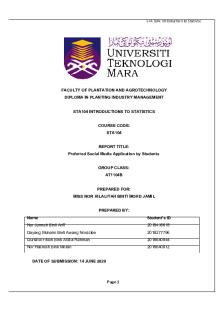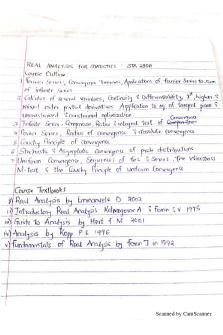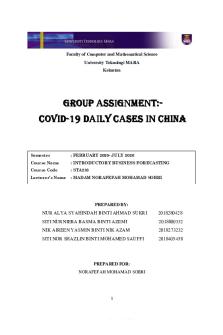STA 104 Assignment PDF

| Title | STA 104 Assignment |
|---|---|
| Author | Farah Nur Iman |
| Course | Introduction to Statistics |
| Institution | Universiti Teknologi MARA |
| Pages | 21 |
| File Size | 561.5 KB |
| File Type | |
| Total Downloads | 181 |
| Total Views | 422 |
Summary
MARA University of Technology, Kota Kinabalu.Introduction to Statistics (STA 104)Title : Students’ Sleeping Habits in UITM SabahGroup : AC110 2APrepared for : Madam Hazlenah HanafiahBIL NAME MATRIX NO1 Farah Nur Iman Binti Mantaib 2017211174 2 Muhammad Aqil Ikhwandi Bin Mat Zin 2017207932 3 Nur Zula...
Description
MARA University of Technology, Kota Kinabalu.
Introduction to Statistics (STA 104) Title : Students’ Sleeping Habits in UITM Sabah
Group : AC110 2A1
Prepared for : Madam Hazlenah Hanafiah
BIL 1 2 3
NAME Farah Nur Iman Binti Mantaib Muhammad Aqil Ikhwandi Bin Mat Zin Nur Zulaikha Binti Saideh
MATRIX NO 2017211174 2017207932 2017212388
1
TABLE OF CONTENT No. 1. 2. 3. 4. 5. 6. 7. 8.
Particulars Table of Content Acknowledgement Abstract Literature Review Description of Data Method of Analysis Findings Conclusion
Page No. 2 3 4 4 5-6 7 8-21 22
2
ACKNOWLEDGEMENT We as a team would like to show our deepest gratitude to everyone who made this possible, especially to our God, Allah SWT. Not to mention our STA104 lecturer, Madam Hazlenah binti Hanafiah who had guide us throughout this assignment. Next, to our parents who are always supporting us through their prayers even though we are far from them, we would like to thank them too. Not to forget to all of our friends who have helped us directly or indirectly, we appreciated all of them. Lastly, we are all grateful for each other because all of us gave our cooperation in making this assignment possible.
3
1.0 INTRODUCTION 1.1 ABSTRACT Sleep plays a very important role in a human being’s health. Sleep loss not only makes people feel sleepy in the daytime, it is even a possible risk factor for Alzheimer’s disease. Most sleep specialists indicate that adult humans require approximately 8 hours of sleep per day. It has been reported that the history of sleep research can be traced back to the 19th century. Researchers have investigated the relationship between sleep deprivation and two variables, task performance and individual productivity. Additionally, sleep deprivation has been negatively related to academic performance. One study showed that sleep-deprived students performed worse on attention, memory, and problem-solving tasks and this adversely affected their academic performance. Adolescents suffer from increasing school, family and social pressure and from an environmentally induced delay of sleep timing. Taken together, these altered sleep patterns lead to a marked increase in sleepiness that usually facilitates cognitive, emotional, behavioural and academic failure. Nevertheless, the common belief that disrupted or poor sleep is usually followed by inefficient daytime behaviour and variability in performance. Within these activities, academic performance and school achievement should be carefully taken into consideration. As recently pointed out in some literature reviews learning abilities and consequent academic performance are particularly dependent on sleep patterns and sleepiness levels. Most of the students in UiTM are either addicted to games, social networking or both. Students nowadays like to play games such as Mobile Legends and Rules of Survival as well as addiction to social networking including Facebook and Twitter affects sleep quality and quantity. Thus, it is reasonable to suppose that those university students that develop such sleep patterns may suffer consequences over their academic performance. 1.2 LITERATURE REVIEW Sleep is critical for maintaining a healthy life. Humans typically need 6 to 8 hours of sleep per day. Although the amount of sleep varies on the individual and it’s very important to maintain good health, a sufficient amount of sleep isn’t prioritised by civilians nowadays. Sleep debt is the accumulated sleep that is lost to poor sleeping behaviours. Sleep debt can also be contributed through a poor quality of sleep. It should be mentioned that sleep quality is as important as sleep quantity. Some people may feel rested with a few hours of sleep per night, but studies show that reduced sleep hours is associated with low performance on complex mental tasks which university students go through in their studies. Hence, sleep quality is important for them. 4
2.0 METHODOLOGY
2.1 DESCRIPTION OF DATA Population
: All students of UiTM Sabah students
Sample
: 30 students of UiTM Sabah Students
Sampling technique
: Stratified sampling technique
Data Collection Method : Questionnaires were distributed to all 30 students who have been randomly chosen. The respondents are students of different faculties. After they have completed answering the questionnaire, it was immediately collected. The respond rate was 100%. It took a few days to complete all questionnaires.
MEASUREMENT SCALE
DESCRIPTION OF SECTION
TYPES OF VARIABLE
B
Demographic
ITEM
A
NAME OF THE QUESTIONNAIRE
SECTION
Description of Variables :
Question 1 Question 2 Question 3 Question 4 Question 5
Qualitative Quantitative Qualitative Qualitative Qualitative
Nominal Ratio Nominal Nominal Ordinal
Question 1
Qualitative
Nominal
Question 2
Quantitative
Ratio
Question 3
Qualitative
Nominal
of staying up
Question 4
Qualitative
Nominal
late How often
Question 5
Qualitative
Ratio
Gender Age CGPA Faculty Part Time of usual sleep Hours of sleep Quality sleep Main reason
staying up 5
late for study How often taking naps Difficulties sleeping Oversleepin g Alarm clock Reason of waking up in the middle
Question 6
Qualitative
Ratio
Question 7
Qualitative
Nominal
Question 8
Qualitative
Nominal
Question 9
Qualitative
Nominal
Question 10
Qualitative
Nominal
of the night
6
2.2 METHOD OF ANALYSIS No.
Element
1. 2. 3. 4.
Gender Age CGPA Faculty
1. 2. 3. 4.
Sleep time Amount of sleep Sleep quality Reason staying up Frequency of doing
5.
homework while being
6. 7. 8.
sleepy Frequency of afternoon naps Difficulty of falling asleep Oversleeping or
Minimum Maximum PART A 1 2 2 3 4 6 1 5 PART B 4 7 2 5 1 2 1 5
Median
S.D
1.00 3.00 5.00 1.50
0.507 0.407 0.699 1.106
6.00 2.00 2.00 2.00
0.925 0.932 0.450 1.224
1
4
2.00
0.820
2
4
2.00
0.868
1
2
1.00
0.450
1
2
1.00
0.479
9.
Waking up too early Alarm clock usage Reason for waking up
1
2
1.00
4.30
10.
in the middle of the
1
5
2.00
1.522
night
7
3.0 FINDINGS 3.1 DEMOGRAPHIC PROFILE
Frequency Valid
Female Male Total
Respondents’ Gender Valid Percentage (%) 50 50 100
15 15 30
Percentage (%) 50 50 100
Cumulative percentage (%) 50 100
The following pie chart shows the gender group of 30 UITM Sabah students who took the questionnaire.
Genders of 30 UITM Sabah Students Who Took The Questionnaire Male
50.00%
Female
50.00%
Based on Figure 1.1, the number of female students and male students who took the questionnaire are equal which is 15 females and 15 males.
Frequency
Respondents’ Age Percentage
Valid
Cumulative
(%) Percentage (%) percentage (%) < 18 1 4 4 4 19-20 22 73 73 77 21-22 7 23 23 100 23-24 0 0 0 100 25
3.33%
73.33%
Frequency Valid
1am Total
0 0 3 7 13 7 30
0 0 10 23.33 43.34 23.33 100
0 0 10 23.33 43.34 23.33 100
0 0 10 33.33 76.67 100
Sleeping Time 14 12 10 8 Frequency
6 4 2 0 1
am
Figure 1.5
Figure 1.5 shows the usual sleeping time of respondents during the night. 3 of them go to sleep between 10pm to 11pm, while 7 of the respondents go to sleep around 11pm to 12am. Most of the respondents, 13 of them, sleep at around 12am to 1am and there are 7 respondents who usually go to sleep after 1am.
11
Valid
Respondents’ Hours of Sleep Valid Percentage Frequency (%) Percentage (%)
Cumulative percentage (%)
< 4 hours
3
10
10
10
4-6 hours 6-8 hours 8-10 hours 11-12 hours > 12 hours
16 8 2 0 1
53.33 26.67 6.67 0 3.33
53.33 26.67 6.67 0 3.33
63.33 90 96.67 0 100
Hours of Sleep 18 16 14 12 10 8 6 4 2 0
Frequency
1
2
s ur ho
Figure 1.6
Valid
Figure 1.6 shows the number of hours of the respondents daily sleeping hours. 3 of the respondents sleep for less than 4 hours a day. Most of the respondents, 16 of them, sleep for around 4 to 6 hours a day, while 2 of them sleep for around 8 to 10 hours a day. None of the respondents sleep for 10 to 12 hours a day but one of them sleeps for more than 12 hours a day.
Yes No Total
Respondents’ Quality of Sleep Percentage Valid Frequency (%) Percentage (%) 8 26.67 26.67 22 73.33 73.33 30 100 100
Cumulative percentage (%) 26.67 100 100
12
Quality of Sleep Yes
No
26.67%
73.33%
Figure 1.7 Figure 1.7 shows the respondents’ quality of sleep. 8 of the respondents which is equal to 27% get quality sleep during the night whereas 22 of them, which is equivalent to 73% do not get quality sleep during the night.
Valid
Respondents’ Reasons of Staying Up Late Valid Percentage Frequency (%) Percentage (%)
Cumulative percentage (%)
Studying
12
40
40
40
Playing Games Going online on social media Going on late night
4
13.33
13.33
53.33
11
36.67
36.67
90
1
3.33
3.33
93.33
13
hangouts/supper Others Total
2 30
6.67 100
6.67 100
100
Reasons Staying Up Late 14 12 10 8 6 4 2 0 in dy u St
g Pl
in ay
es am G g
in Go
in nl o g
n eo
ed m l a ci so
g in Go
on
ia
t igh n e lat
ou ng a h
pp su / ts
er
rs he t O
Frequency
Figure 1.8 Figure 1.8 shows why the respondents chose to stay up late. Most of them, which consist of 12 of the respondents, stay up late to study. 4 of the respondents stay up late to play games. 11 of the respondents chose to go online on their social media platforms during late night. 1 of them stays up late because of going on late night hangouts and 2 of them have other reasons for staying up late at night.
Respondents’ Frequency of Staying Up for Studies Despite Being Sleepy Valid Cumulative Percentage Frequency (%) Percentage (%) percentage (%)
Valid
Never Once or twice a week 3-5 times a week Almost everyday Total
2
6.67
6.67
6.67
16
53.33
53.33
60
8 4 30
26.67 13.33 100
26.67 13.33 100
86.67 100
14
How Often Staying Up for Studies Despite Being Sleepy
Never Once or twice a week 3-5 times a week Almost everyday
Figure 1.9 Figure 1.9 shows how frequent the respondents study despite being sleepy at night. 2 of them respondents, which are around 7%, never study while being sleepy. 16 of them, 53% of the respondents, study despite being sleepy once or twice a week. 8 of them, 27% of the respondents study 3 to 5 times a week despite being sleepy. Lastly, 4 of them, 3% of the respondents studies almost daily despite being sleepy.
15
Respondents’ Frequency of Taking Afternoon Naps Valid Percentage Frequency (%) Percentage (%)
Valid
Never Once or twice a week 3-5 times a week Almost everyday Total
Cumulative percentage (%)
0
0
0
0
16
53.33
53.33
53.33
6 8 30
20 26.67 100
20 26.67 100
73.33 100
Taking Afternoon Naps
Never Once or twice a week 3-5 times a week Almost everyday
Figure 2.0
Valid
Figure 2.0 shows the frequency of students taking afternoon naps in a week. All of the respondents take afternoon naps throughout the week, which are 16 of them once or twice a week, 6 of them 3 to 5 times a week and 8 of them take afternoon naps almost daily in a week.
Yes No Total
Respondents’ Difficulties to Sleep Valid Percentage Frequency (%) Percentage (%) 22 73.33 73.33 8 26.67 26.67 30 100 100
Cumulative percentage (%) 73.33 100
16
Difficulties Sleeping
Yes No
Table 2.1
Valid
Table 2.1 shows whether the respondents have difficulties in falling asleep during the night. 22 of the respondents which is equivalent to 73% of them do have difficulties falling asleep at night whereas 8 of them which is equivalent to 27% of the respondents do not have any difficulties falling asleep.
Respondents’ Respond To Oversleeping or Waking Up Too Early Percentage Valid Cumulative Frequency (%) Percentage (%) percentage (%) Yes 20 66.67 66.67 66.67 No 10 33.33 33.33 100 Total 30 100 100
17
Oversleeping / Waking Up Too Early
Yes No
Table 2.2 Table 2.2 shows whether the respondents have problems of oversleeping or waking up too early than intended. 20 of the respondents do have the stated problems while the remaining 10 of them do not.
Respondents’ Respond To Using Alarm Clock Percentage Valid
Cumulative ercentage (%) 76.67 100
Alarm Clock
Yes No
18
Table 2.3
Table 2.3 shows whether the respondents use an alarm clock to wake up in the morning. 23 of them (77%) do use an alarm clock to wake up in the morning whereas 7 of them (23%) do not.
Valid
Respondents’ Reasons of Waking Up In The Middle of the Night Valid Cumulative Percentage Frequency (%) Percentage (%) percentage (%) Too hot/cold
9
30
30
30
Sudden noises Thirst/Hunger Others Don't wake up Total
7 4 5 5 30
23.33 13.33 16.67 16.67 100
23.33 13.33 16.67 16.67 100
53.33 66.66 83.33 100
19
Reasons of Waking Up in the Middle of the Night 10 9 8 7 6 5 4 Axis Title 3 2 1 0
Table 2.4 Table 2.4 shows why the respondents wake up in the middle of the night. Most of the respondents which is 9 of them, wake up because of uncomfortable temperature whereas 7 of them wake up because of being disturbed by sudden noises. 4 of the respondents wake up because of feeling thirsty or hungry in the middle of the night and 5 of the respondents have other reasons whereas 5 of the respondents do not wake up in the middle of the night at all.
4.0 CONCLUSION After executing this assignment, it is strongly believed that proper sleep quality and quantity is very important and is very beneficial towards university students. While some students may neglect their sleeping needs and still may get somewhat good results in their studies, but it’s proven that students’ academic performance has a positive relationship with the students’ sleeping quality and quantity. It is advisable that students should at least gain at least 7 hours of sleep everyday but however these hours of sleep can be topped off with afternoon naps and not just a night’s sleep. Moreover, students should also ensure that anything that may deter them from having a quality sleep be taken care of before sleeping to ensure a quality sleep.
20
21...
Similar Free PDFs

STA 104 Assignment
- 21 Pages

Assignment STA Written Report
- 19 Pages

PAD 104 Group Assignment
- 21 Pages

Group Assignment PAD 104 (8
- 18 Pages

GProject STA 220
- 24 Pages

STA 2306 REAL Analysis
- 39 Pages

Fisica tecnica per STA
- 35 Pages

STA 2321 Numerical Analysis
- 69 Pages

Group Project STA 233
- 33 Pages

Sta rosa laguna ordinance
- 26 Pages

Engineering Statistics STA 3032
- 6 Pages

STA Quiz 16 Practice
- 3 Pages

Sta Maria Reviewer 2010 2011
- 92 Pages

STA 205 Composite Notes (NKU)
- 20 Pages
Popular Institutions
- Tinajero National High School - Annex
- Politeknik Caltex Riau
- Yokohama City University
- SGT University
- University of Al-Qadisiyah
- Divine Word College of Vigan
- Techniek College Rotterdam
- Universidade de Santiago
- Universiti Teknologi MARA Cawangan Johor Kampus Pasir Gudang
- Poltekkes Kemenkes Yogyakarta
- Baguio City National High School
- Colegio san marcos
- preparatoria uno
- Centro de Bachillerato Tecnológico Industrial y de Servicios No. 107
- Dalian Maritime University
- Quang Trung Secondary School
- Colegio Tecnológico en Informática
- Corporación Regional de Educación Superior
- Grupo CEDVA
- Dar Al Uloom University
- Centro de Estudios Preuniversitarios de la Universidad Nacional de Ingeniería
- 上智大学
- Aakash International School, Nuna Majara
- San Felipe Neri Catholic School
- Kang Chiao International School - New Taipei City
- Misamis Occidental National High School
- Institución Educativa Escuela Normal Juan Ladrilleros
- Kolehiyo ng Pantukan
- Batanes State College
- Instituto Continental
- Sekolah Menengah Kejuruan Kesehatan Kaltara (Tarakan)
- Colegio de La Inmaculada Concepcion - Cebu

